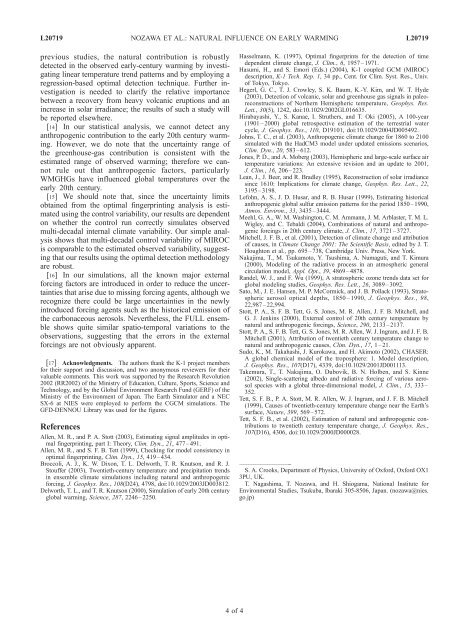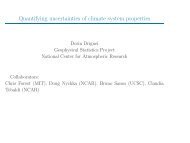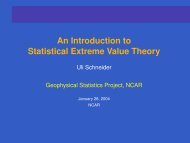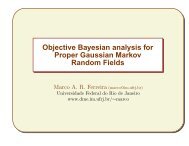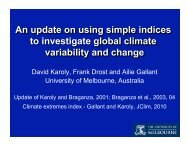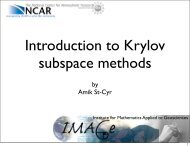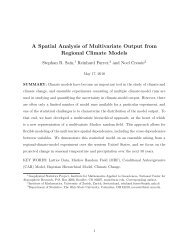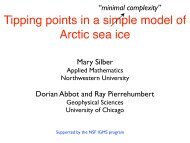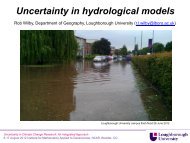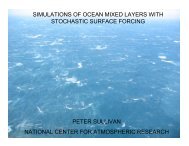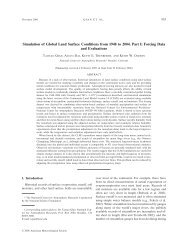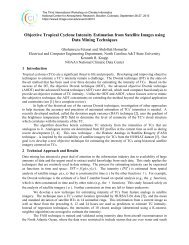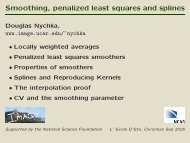Detecting natural influence on surface air temperature ... - IMAGe
Detecting natural influence on surface air temperature ... - IMAGe
Detecting natural influence on surface air temperature ... - IMAGe
You also want an ePaper? Increase the reach of your titles
YUMPU automatically turns print PDFs into web optimized ePapers that Google loves.
L20719 NOZAWA ET AL.: NATURAL INFLUENCE ON EARLY WARMING L20719previous studies, the <str<strong>on</strong>g>natural</str<strong>on</strong>g> c<strong>on</strong>tributi<strong>on</strong> is robustlydetected in the observed early-century warming by investigatinglinear <strong>temperature</strong> trend patterns and by employing aregressi<strong>on</strong>-based optimal detecti<strong>on</strong> technique. Further investigati<strong>on</strong>is needed to clarify the relative importancebetween a recovery from heavy volcanic erupti<strong>on</strong>s and anincrease in solar irradiance; the results of such a study willbe reported elsewhere.[14] In our statistical analysis, we cannot detect anyanthropogenic c<strong>on</strong>tributi<strong>on</strong> to the early 20th century warming.However, we do note that the uncertainty range ofthe greenhouse-gas c<strong>on</strong>tributi<strong>on</strong> is c<strong>on</strong>sistent with theestimated range of observed warming; therefore we cannotrule out that anthropogenic factors, particularlyWMGHGs have <str<strong>on</strong>g>influence</str<strong>on</strong>g>d global <strong>temperature</strong>s over theearly 20th century.[15] We should note that, since the uncertainty limitsobtained from the optimal fingerprinting analysis is estimatedusing the c<strong>on</strong>trol variability, our results are dependent<strong>on</strong> whether the c<strong>on</strong>trol run correctly simulates observedmulti-decadal internal climate variability. Our simple analysisshows that multi-decadal c<strong>on</strong>trol variability of MIROCis comparable to the estimated observed variability, suggestingthat our results using the optimal detecti<strong>on</strong> methodologyare robust.[16] In our simulati<strong>on</strong>s, all the known major externalforcing factors are introduced in order to reduce the uncertaintiesthat arise due to missing forcing agents, although werecognize there could be large uncertainties in the newlyintroduced forcing agents such as the historical emissi<strong>on</strong> ofthe carb<strong>on</strong>aceous aerosols. Nevertheless, the FULL ensembleshows quite similar spatio-temporal variati<strong>on</strong>s to theobservati<strong>on</strong>s, suggesting that the errors in the externalforcings are not obviously apparent.[17] Acknowledgments. The authors thank the K-1 project membersfor their support and discussi<strong>on</strong>, and two an<strong>on</strong>ymous reviewers for theirvaluable comments. This work was supported by the Research Revoluti<strong>on</strong>2002 (RR2002) of the Ministry of Educati<strong>on</strong>, Culture, Sports, Science andTechnology, and by the Global Envir<strong>on</strong>ment Research Fund (GERF) of theMinistry of the Envir<strong>on</strong>ment of Japan. The Earth Simulator and a NECSX-6 at NIES were employed to perform the CGCM simulati<strong>on</strong>s. TheGFD-DENNOU Library was used for the figures.ReferencesAllen, M. R., and P. A. Stott (2003), Estimating signal amplitudes in optimalfingerprinting, part I: Theory, Clim. Dyn., 21, 477–491.Allen, M. R., and S. F. B. Tett (1999), Checking for model c<strong>on</strong>sistency inoptimal fingerprinting, Clim. Dyn., 15, 419–434.Broccoli, A. J., K. W. Dix<strong>on</strong>, T. L. Delworth, T. R. Knuts<strong>on</strong>, and R. J.Stouffer (2003), Twentieth-century <strong>temperature</strong> and precipitati<strong>on</strong> trendsin ensemble climate simulati<strong>on</strong>s including <str<strong>on</strong>g>natural</str<strong>on</strong>g> and anthropogenicforcing, J. Geophys. Res. , 108 (D24), 4798, doi:10.1029/2003JD003812.Delworth, T. L., and T. R. Knuts<strong>on</strong> (2000), Simulati<strong>on</strong> of early 20th centuryglobal warming, Science, 287, 2246–2250.Hasselmann, K. (1997), Optimal fingerprints for the detecti<strong>on</strong> of timedependent climate change, J. Clim., 6, 1957–1971.Hasumi, H., and S. Emori (Eds.) (2004), K-1 coupled GCM (MIROC)descripti<strong>on</strong>, K-1 Tech. Rep. 1, 34 pp., Cent. for Clim. Syst. Res., Univ.of Tokyo, Tokyo.Hegerl, G. C., T. J. Crowley, S. K. Baum, K.-Y. Kim, and W. T. Hyde(2003), Detecti<strong>on</strong> of volcanic, solar and greenhouse gas signals in paleorec<strong>on</strong>structi<strong>on</strong>sof Northern Hemispheric <strong>temperature</strong>, Geophys. Res.Lett., 30(5), 1242, doi:10.1029/2002GL016635.Hirabayashi, Y., S. Kanae, I. Struthers, and T. Oki (2005), A 100-year(1901 – 2000) global retrospective estimati<strong>on</strong> of the terrestrial watercycle, J. Geophys. Res., 110, D19101, doi:10.1029/2004JD005492.Johns, T. C., et al. (2003), Anthropogenic climate change for 1860 to 2100simulated with the HadCM3 model under updated emissi<strong>on</strong>s scenarios,Clim. Dyn., 20, 583–612.J<strong>on</strong>es, P. D., and A. Moberg (2003), Hemispheric and large-scale <strong>surface</strong> <strong>air</strong><strong>temperature</strong> variati<strong>on</strong>s: An extensive revisi<strong>on</strong> and an update to 2001,J. Clim., 16, 206–223.Lean, J., J. Beer, and R. Bradley (1995), Rec<strong>on</strong>structi<strong>on</strong> of solar irradiancesince 1610: Implicati<strong>on</strong>s for climate change, Geophys. Res. Lett., 22,3195–3198.Lefohn, A. S., J. D. Husar, and R. B. Husar (1999), Estimating historicalanthropogenic global sulfur emissi<strong>on</strong> patterns for the period 1850–1990,Atmos. Envir<strong>on</strong>., 33, 3435–3444.Meehl, G. A., W. M. Washingt<strong>on</strong>, C. M. Ammann, J. M. Arblaster, T. M. L.Wigley, and C. Tebaldi (2004), Combinati<strong>on</strong>s of <str<strong>on</strong>g>natural</str<strong>on</strong>g> and anthropogenicforcings in 20th century climate, J. Clim., 17, 3721–3727.Mitchell, J. F. B., et al. (2001), Detecti<strong>on</strong> of climate change and attributi<strong>on</strong>of causes, in Climate Change 2001: The Scientific Basis, edited by J. T.Hought<strong>on</strong> et al., pp. 695–738, Cambridge Univ. Press, New York.Nakajima, T., M. Tsukamoto, Y. Tsushima, A. Numaguti, and T. Kimura(2000), Modeling of the radiative process in an atmospheric generalcirculati<strong>on</strong> model, Appl. Opt., 39, 4869–4878.Randel, W. J., and F. Wu (1999), A stratospheric oz<strong>on</strong>e trends data set forglobal modeling studies, Geophys. Res. Lett., 26, 3089–3092.Sato, M., J. E. Hansen, M. P. McCormick, and J. B. Pollack (1993), Stratosphericaerosol optical depths, 1850 –1990, J. Geophys. Res., 98,22,987–22,994.Stott, P. A., S. F. B. Tett, G. S. J<strong>on</strong>es, M. R. Allen, J. F. B. Mitchell, andG. J. Jenkins (2000), External c<strong>on</strong>trol of 20th century <strong>temperature</strong> by<str<strong>on</strong>g>natural</str<strong>on</strong>g> and anthropogenic forcings, Science, 290, 2133–2137.Stott, P. A., S. F. B. Tett, G. S. J<strong>on</strong>es, M. R. Allen, W. J. Ingram, and J. F. B.Mitchell (2001), Attributi<strong>on</strong> of twentieth century <strong>temperature</strong> change to<str<strong>on</strong>g>natural</str<strong>on</strong>g> and anthropogenic causes, Clim. Dyn., 17, 1 – 21.Sudo, K., M. Takahashi, J. Kurokawa, and H. Akimoto (2002), CHASER:A global chemical model of the troposphere: 1. Model descripti<strong>on</strong>,J. Geophys. Res., 107(D17), 4339, doi:10.1029/2001JD001113.Takemura,T.,T.Nakajima,O.Dubovik,B.N.Holben,andS.Kinne(2002), Single-scattering albedo and radiative forcing of various aerosolspecies with a global three-dimensi<strong>on</strong>al model, J. Clim., 15, 333–352.Tett, S. F. B., P. A. Stott, M. R. Allen, W. J. Ingram, and J. F. B. Mitchell(1999), Causes of twentieth-century <strong>temperature</strong> change near the Earth’s<strong>surface</strong>, Nature, 399, 569–572.Tett, S. F. B., et al. (2002), Estimati<strong>on</strong> of <str<strong>on</strong>g>natural</str<strong>on</strong>g> and anthropogenic c<strong>on</strong>tributi<strong>on</strong>sto twentieth century <strong>temperature</strong> change, J. Geophys. Res.,107(D16), 4306, doi:10.1029/2000JD000028.S. A. Crooks, Department of Physics, University of Oxford, Oxford OX13PU, UK.T. Nagashima, T. Nozawa, and H. Shiogama, Nati<strong>on</strong>al Institute forEnvir<strong>on</strong>mental Studies, Tsukuba, Ibaraki 305-8506, Japan. (nozawa@nies.go.jp)4of4


